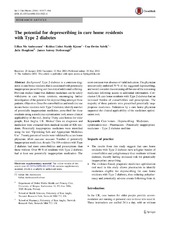| dc.contributor.author | Andreassen, Lillan Mo | en_US |
| dc.contributor.author | Kjome, Reidun Lisbet Skeide | en_US |
| dc.contributor.author | Sølvik, Una Ørvim | en_US |
| dc.contributor.author | Houghton, Julie | en_US |
| dc.contributor.author | Desborough, James Antony | en_US |
| dc.date.accessioned | 2017-01-02T12:33:07Z | |
| dc.date.available | 2017-01-02T12:33:07Z | |
| dc.date.issued | 2016-08 | |
| dc.Published | International Journal of Clinical Pharmacy 2016, 38(4):977-984 | eng |
| dc.identifier.issn | 2210-7711 | |
| dc.identifier.uri | https://hdl.handle.net/1956/15327 | |
| dc.description.abstract | Background Type 2 diabetes is a common diagnosis in care home residents that is associated with potentially inappropriate prescribing and thus risk of additional suffering. Previous studies found that diabetes medicines can be safely withdrawn in care home residents, encouraging further investigation of the potential for deprescribing amongst these patients. Objectives Describe comorbidities and medicine use in care home residents with Type 2 diabetes; identify number of potentially inappropriate medicines prescribed for these residents using a medicines optimisation tool; assess clinical applicability of the tool. Setting Thirty care homes for older people, East Anglia, UK. Method Data on diagnoses and medicines were extracted from medical records of 826 residents. Potentially inappropriate medicines were identified using the tool ‘Optimising Safe and Appropriate Medicines Use’. Twenty percent of results were validated by a care home physician. Main outcome measure Number of potentially inappropriate medicines. Results The 106 residents with Type 2 diabetes had more comorbidities and prescriptions than those without. Over 90 % of residents with Type 2 diabetes had at least one potentially inappropriate medication. The most common was absence of valid indication. The physician unreservedly endorsed 39 % of the suggested deprescribing, and would consider discontinuing all but one of the remaining medicines following access to additional information. Conclusion UK care home residents with Type 2 diabetes had an increased burden of comorbidities and prescriptions. The majority of these patients were prescribed potentially inappropriate medicines. Validation by a care home physician supported the clinical applicability of the medicines optimisation tool. | en_US |
| dc.language.iso | eng | eng |
| dc.publisher | Springer | eng |
| dc.rights | Attribution CC BY | eng |
| dc.rights.uri | http://creativecommons.org/licenses/by/4.0 | eng |
| dc.subject | Care homes | eng |
| dc.subject | Deprescribing | eng |
| dc.subject | Medicines optimisation tool | eng |
| dc.subject | Pharmacists | eng |
| dc.subject | Potentially inappropriate medicines | eng |
| dc.subject | Type 2 diabetes mellitus | eng |
| dc.title | The potential for deprescribing in care home residents with Type 2 diabetes | en_US |
| dc.type | Peer reviewed | |
| dc.type | Journal article | |
| dc.date.updated | 2016-12-15T10:46:48Z | |
| dc.description.version | publishedVersion | en_US |
| dc.rights.holder | Copyright 2016 The Author(s) | |
| dc.identifier.doi | https://doi.org/10.1007/s11096-016-0323-4 | |
| dc.identifier.cristin | 1411058 | |

